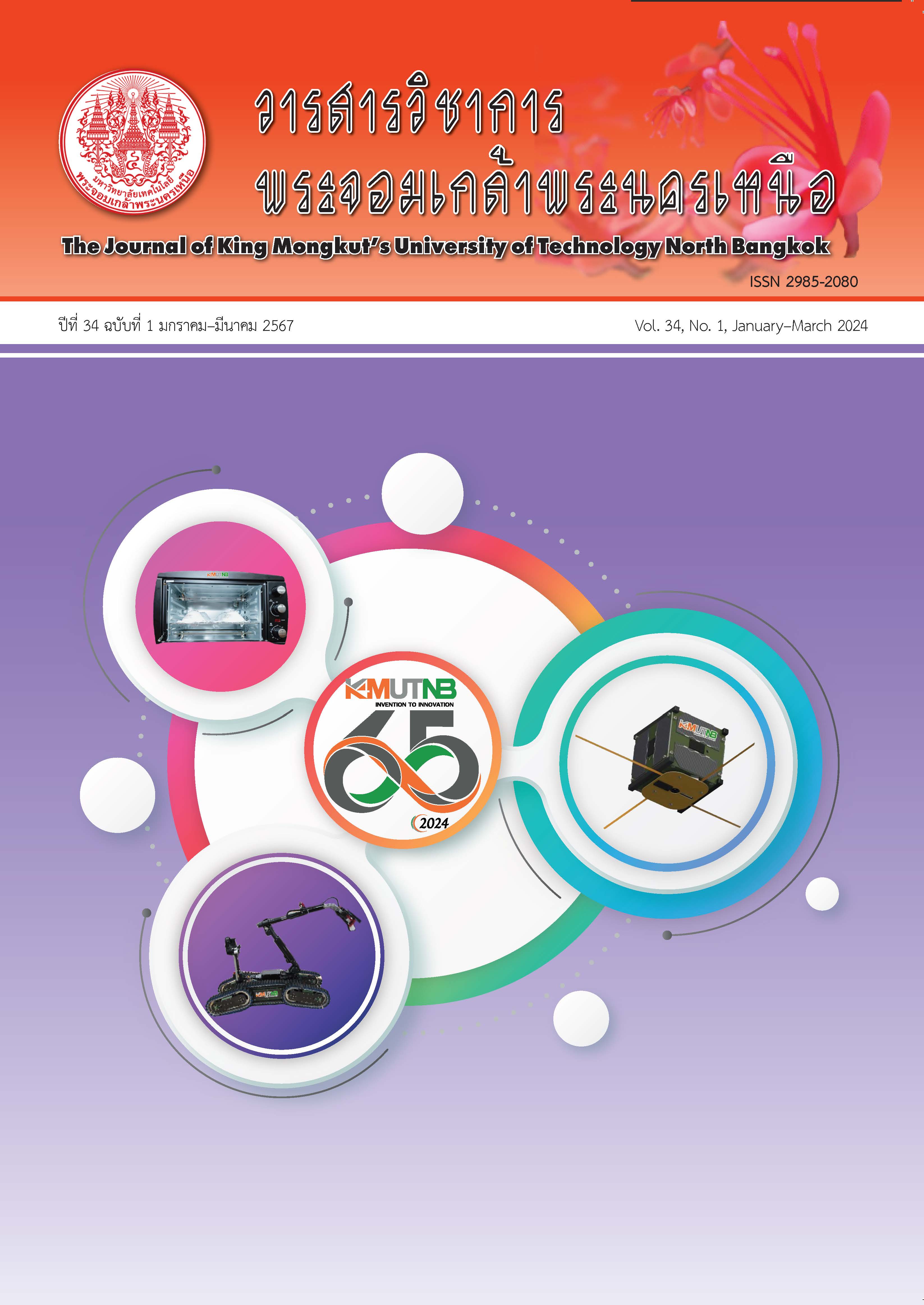Development of a Biomass Briquette Machine from Agricultural Waste in Rayong Province
Main Article Content
Abstract
Biomass briquette charcoal has been studied using a variety of agricultural waste materials. The outcome revealed that the charcoal bars are still inefficient in use because of their fragility, high moisture causing mold, difficulty setting up, short burning times, and smoky. The aims of this research are to build up a biomass charcoal briquette machine and to examine the raw material proportions. Durian peel and mangosteen peel charcoal were mixed with cassava starch. The mixing ratio by weight between Durian peel and mangosteen peel was 4 : 1, 2 : 1, 3 : 2, 1 : 1, 2 : 3, 1 : 2, and 1 : 4. The biomass charcoal briquette machine was evaluated for its forming ability, physical shape, and density while the properties of charcoal briquettes were analyzed based on American Society of Testing and Materials (ASTM). The results reveal that this machine is efficient to use considered by smooth surface, sturdiness, and density (604.94–612.12 kg/m3). The charcoal briquettes made from durian peel and mangosteen peel in the ratio of 1 : 4 can be achieved all criteria which have the highest calorific value of 5,572.78 kcal/kg, the lowest moisture content of 4.82%, the minimum volatile matter content of 7.26%, the minimum ash content of 9.47%, the maximum fixed carbon of 75.39%. Also, it has a bulk density of 606.32 kg/m3, a heat utilization efficiency of 22.79%, and a burning time of 99.47 minutes.
Article Details

This work is licensed under a Creative Commons Attribution-NonCommercial-NoDerivatives 4.0 International License.
The articles published are the opinion of the author only. The author is responsible for any legal consequences. That may arise from that article.
References
DEDE. (2020, Dec.). Energy Situation January – December 2020. Ministry of Energy, Thailand. [Online]. Available: https://www.dede.go.th/ download/stat63/fontpage_dec2020.pdf
A. Ussawarujkulchai, C. Semsayun, N. Prapakdee, N. Pieamsuwansiri, and N. Chuchat, “Utilization of durian and mangosteen peels as briquette fuel,” in the Proceeding of 49th Kasetsart University Annual Conference: Science, Bangkok, 2011, pp. 162–168 (in Thai).
K. Boonchom and N. Chaisompan, “Study of charcoal briquette from longan wood,” Naresuan Phayao Journal, vol. 13, no. 2, pp. 51–56, 2020 (in Thai).
K. Sukaranandana and N. Tanpaiboonkul, “Utilization of cassava residue from agro- Industry as binder with powder of Palmyra palm fruit peel charcoal for briquettes fuel production,” Veridian E-Journal, vol. 6, no. 5, pp. 48–65, 2019 (in Thai).
V. Yubolket and D. Settheetham, “Quality Comparison of leaf-trash chunk-compressed fuel by compressor and hand,” KKU Research Journal (Graduate Studies), vol. 17, no. 4, pp. 85–96, 2017 (in Thai).
Thai Industrial Standards Institute (TISI), Community Products Standard No. 238, 2004.
A. Kitipattaworn, P. Reubroycharoen, and W. Uttamaprakorn, “Briquette fuel from co-production of ethanol industrial wet cake and biomass,” Journal of Energy Research, vol. 10, no. 3, pp. 43–56, 2013.
S. Mongkolchaichana and P. Wongkhankaew, “Development of a biomass briquetting machine from rice straw,” in GNRU Proceeding, Phitsanulok, 2017, pp. 2307–2317.
P. Yooman, “Development of a cold production biomass charcoal briquette machine to use waste from coffee bean processing,” I-Tech Journal LPRU, vol. 9, no. 1, pp. 34–48, 2016 (in Thai)
S. Ramanchit, “Design and development of charcoal screw-press briquette machine with automatic cutting,” I-Tech Journal TRU, vol. 14, no. 2, pp. 9–13, 2019 (in Thai)
K. Namwong and M. Kanaphan, “Design and development of a briquette machine for briquettes production from dried neem leaves and burned sawdust,” in ME-NETT, Nakorn Nayok, 2017, pp. AEC 06.
J. Arévaloa, G. Quispea, and C. Raymundob, “Sustainable energy model for the production of biomass briquettes based on rice husk in low-income agricultural areas in Peru,” Energy Procedia, vol. 141, pp. 138–145, 2017.
L. Wattanachira, N. Laapan, V. Chatchavarn, and A. Thanyacharoen, “Development of biobriquettes from mixed rice-straw and longan waste residues,” KMUTT R&D Journal, vol. 39, no. 2, pp. 239–255, 2016. (in Thai).
ASTM International Standard Test Method for Moisture in the Analysis Sample of Coal and Coke, ASTM Standard D3173, 2017.
ASTM International Standard Test Method for Volatile Matter in the Analysis Sample of Coal and Coke, ASTM Standard D3175, 2020.
ASTM International Standard Test Method for Ash in the Analysis Sample of Coal and Coke from Coal, ASTM Standard D3174, 2020.
ASTM International Standard Practice for Proximate Analysis of Coal and Coke, ASTM Standard D3172, 2021.
ASTM International Standard Test Method for Gross Calorific Value of Coal and Coke, ASTM Standard D5865, 2019.
K. Chaiwong, N. Vicharn, A. Saenthaweesuk, C. Thawonngamyingsakul, and T. Janhom, “Effect of inlet air flow on thermal efficiency of bio-char stove from agricultural waste,” RMUTL Engineering Journal, vol. 1, no. 1, pp. 37–42, 2016 (in Thai).
D. Dangphonthong and W. Pinate, “The promotion of production charcoal briquette from agricultural residues for use in the community household under the philosophy of sufficiency economy,” Mahasarakham University, Mahasarakham, Rep, 2014 (in Thai).
L. Ifa, S. Yani, N. Nurjannah, D. Darnengsih, A. Rusnaenah, M. Mel, M. Mahfud and H. S. Kusuma, “Techno-economic analysis of bio-briquette from cashew nut shell waste,” Heliyon, vol. 6, no. 9, 2020.
S. Sawekwiharee, “Potential energy of the fuel briquettes from mangosteen shell,” Rajamangala University of Technology Phra Nakhon, Bangkok, Rep. 2012 (in Thai).
T. Chaichana, J. Waewsak, J. Kaew-On and U. Onthong , “Fuel properties of mangosteen pericarp charcoal,” Thaksin University Journal, vol. 17, no. 3, pp. S29–36, 2014 (in Thai).
DAE. (2020, Dec.). Economic Plants Database in Rayong, 2019–2020. Ministry of Agriculture and Cooperatives, Thailand. [Online]. (in Thai). Available: http://www.rayong.doae.go.th/ eco%20province%2063.pdf

